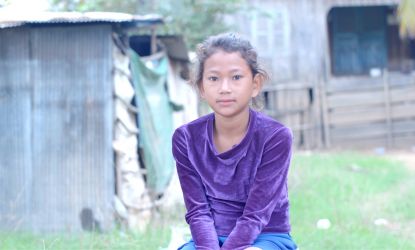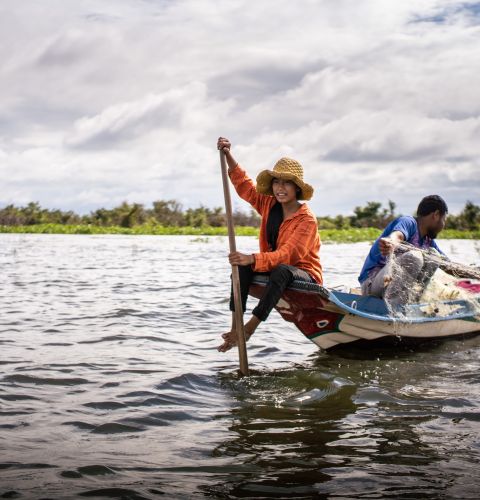Millions of women and girls living in the world’s poorest countries are facing the most devastating effects of climate change.
Find out about the climate crisis, how it affects women and girls, and what ActionAid is doing to help.
What is climate change and what's causing it?
Extreme patterns of weather such as storms, unpredictable rain, and droughts - caused by rising global temperatures - are destroying livelihoods and displacing millions of people from their homes.
Women and girls living in poverty are particularly vulnerable to the effects of climate change due to existing inequalities.
Climate crises tend to push women and girls further into poverty by destroying their sources of food and income; they increase the burden of unpaid care work on women and girls; and escalate the risks of child marriage, early pregnancy and violence as girls are forced to drop out of school to help support their family.
That's why ActionAid works closely with women and girls to help them adapt to sustainable, climate-proof livelihoods and strengthen their resilience against future crises.
But we urgently need your help to reach as many people as possible.
What ActionAid does to help women and girls fight climate change
ActionAid works with women and girls to strengthen their resilience to climate change in the following ways:
- We empower women and girls to lead change in their communities.
- We work with women to develop alternative livelihoods and income sources during and after times of crisis or long-term changes through innovative farming methods and tools like table gardening, salt-resistant seeds and climate-resilient livestock.
- We train women and girls in disaster risk reduction by helping them to spot early warning signs and ensuring efficient and timely evacuations during floods and storms.
- We work with women to reduce the impact of climate change. For example, we help women in Cambodia plant mangroves to provide flood protection by reducing the force of oncoming waves and storm surges.
- We look for sustainable solutions in all aspects of our work. For example, in Nepal, we teach women and girls to make plastic-free, reusable sanitary pads. This enables them to have easy access to safe sanitary products while helping to protect the environment.
- We also focus on climate justice and recognise the responsibility of wealthy countries in leading rapid climate action.
How does climate change affect women and girls?
Climate change disproportionately affects women and girls because it exacerbates inequalities that women and girls already face.
- Women and girls are more likely to live in poverty than men and face more discrimination that can heighten during and after climate-change-related events such as floods and droughts.
- Extreme weather events threaten natural resources like land and water which women rely on for feeding their families and to make a living.
- Women and girls are less likely to be in positions of power. They have less access to capital, to own land and rarely find themselves in decision-making roles.
- Women and girls bear the heavy burden of increased unpaid care work and responsibilities due to climate change. It is often women and girls, for example, who are forced to walk great distances to find water when local sources dry up.
- When disasters like flooding strike, women and children are more likely to die from death and injury.
- Women and girls face a heightened risk of violence during and following disasters. They are more likely to drop out of school, face early marriage, adolescent pregnancy and rape.
- Women and girls are vulnerable to displacement after climate change-related disasters. They are 80% more likely to be displaced by climate change.4

Flooding in Cambodia
Thousands of people in Cambodia have been affected by climate change-related storms and floods that have damaged their homes and forced them out.
13-year-old Thyda's house has been battered by storms and floods regularly.
When it happened most recently, Thyda’s house flooded, with the water rising as high as her waist. Thyda helped carry her younger siblings to higher ground but she is afraid that next time they will drown.
Thyda's family was displaced for weeks and forced to live in a tent without food for several days.
Girls like Thyda and her family have received food donations and other support from ActionAid.
ActionAid is helping them to develop an independent livelihood and providing boats so children can go to school.
Girls like Thyda face devastation due to climate change
Angkor Films/ActionAid
Women and girls are part of the solution to climate change
Women and girls are most adversely affected by the effects of climate change - but they are also uniquely important to the solution.
Research shows that, when women participate in decision-making at national and community levels, they are key to effective climate change solutions.
Women often have a strong body of knowledge and expertise that can be used in reducing the impacts of disasters and in creating strategies for a more sustainable future.
Their traditional, cultural roles within families mean they often act as stewards of natural and household resources.
Women around the world make decisions that influence the environment, whether it’s as cooks for their families (choosing food and fuel), as farmers (influencing soil carbon emissions), or as consumers (making purchasing decisions).
About ActionAid
ActionAid is an international charity that works with women and girls living in poverty.
Our dedicated local staff are changing the world with women and girls. We are ending violence and fighting poverty so that all women, everywhere, can create the future they want.
We operate in rural and urban communities across Asia, Africa and Latin America.
We're committed to ending the cycle of violence in communities around the world, enabling women's economic empowerment, and supporting women's and girls' rights during humanitarian crises.
Footnotes
- 1https://static1.squarespace.com/static/559d276fe4b0a65ec3938057/t/55f6fe81e4b02545cc71df30/1442250369603/wen-briefing-net2.pdf
- 2https://static1.squarespace.com/static/559d276fe4b0a65ec3938057/t/55f6fe81e4b02545cc71df30/1442250369603/wen-briefing-net2.pdf
- 3https://www.un.org/development/desa/dspd/wp-content/uploads/sites/22/2018/05/9.pdf
- 4file:///Users/arsheen/Downloads/UNDP%20Linkages%20Gender%20and%20CC%20Policy%20Brief%201-WEB%20(1).pdf
Page updated 19 March 2025
